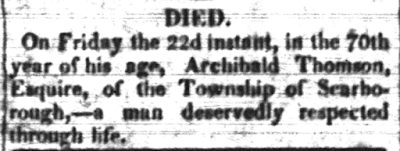Archibald was born in the small town of Westerkirk in Dumfries Scotland in 1749, one of 8 children born to Andrew and Jannet Thomson. He was baptized in the parish church On May 7th.
 |
| Scotland's People Old Parish Registers. Westerkirk 854/00 0010 0057 |
In 1773 he crossed the ocean in search of a better life, settling in Harpersfield in Tryon County, New York State. He farmed with other young Scots, James Park, Daniel Rose and John Chisholm. In 1775 "his attachment to his sovereign caused him to leave what little property he had acquired (12 acres of land) behind him" siding with the British in the American Revolution. He ultimately filed 16 Land Petitions that provided me with details of his service to the Crown. Archibald was a carpenter by trade and initially completed repairs at Fort Oswegatchie and Niagara. He was later appointed Master Carpenter by Governor Abbott. In 1777 he served under Captain John MacDonnell in the Second Battalion of the King's Royal Regiment of New York. In 1778 Archibald joined Captain Joseph Brant and was allegedly arrested by the Rebels for detecting and defeating conspiracies. There he was placed "under sentence of death for joining the Indians and escaped the Americans". I hope to find more about this interesting part of Archibald's story! He and his colleagues served without pay for seven years until the end of the war and "suffered every extremity of distress" and "engaged in the most dangerous of enterprises" under the command of Captain Brant, serving with "all the Zeal and Bravery of Britons". He was ultimately granted a Lieutenant's commission by Lord Dorchester.
On 27 July 1781 Archibald married Elizabeth McKay in Quebec City. Elizabeth was the daughter of Hugh McKay another Scottish refugee from New York State who became the High Constable of Quebec.
 |
| Quebec Gazette 2 August 1781, page 2 |
The couple moved about the province acquiring and selling land in various areas that was acquired by their successful land petitions to the Crown.
 |
| Ontario Archives RG 1-58 Township Papers, Scarborough MS 658 Reel 436 |
Elizabeth acquired land due to her status as a daughter and wife of a Loyalist. Archibald acquired a town lot in Kingston in 1790. He ran a timber yard, wharf and store from this property. In the same time period he also acquired land in Fredericksburg Township as well as in Thurlow Township. In 1793 he also acquired a town lot in Newark (later Niagara on the Lake)and property in Stamford Township. By 1797 he owned a coveted town lot in York (later Toronto) near the St. Lawrence Market. As you can see from this detail from a map from the time his neighbours included his brothers David and Andrew
 |
| Detail from the Peter Russell 1797 map of Toronto, Toronto Public Library |
And here's where Archibald's importance to the province lies - in 1796 he had petitioned the crown for 400 acres of land for his brothers who wished to join him in Canada and settle in Scarborough. He was successful and the rest is history. His brother David and David's wife Mary were the first settlers in Scarborough.
By 1799 Archibald himself joined his siblings in Scarborough purchasing and leasing 4 plots of land. He ran a "house of entertainment" and a grist mill while farming and also acting as a Justice of the Peace. In 1815 he certified his son Edward's land petition. Here's his signature. I found it to be consistent on the various documents over the years.
 |
| Upper Canada Land Petitions, Library and Archives Canada RG 1, L 3, Volume 497 "T" Bundle 10 |
Archibald died on 22 January 1819. Elizabeth had died two years earlier and I believe the couple were originally buried on the family farm. They were reinterred at St. Andrew's Presbyterian Church in Scarborough, the first Presbyterian Church in Scarborough, erected on land donated by the Thomson family. The inscription is difficult to decipher but reads: "Their remains moved to this place on June 3 1854 by their descendants numbering 231".
 |
| Picture taken by the writer |
Archibald's demise was noted in the Upper Canada Gazette on the 28th of January 1819. He received a fine tribute:
 |
| Upper Canada Gazette, 28 January 1819, page 2 |
Archibald had packed a lot into his 70 years probably beyond what he expected as a young boy in Dumfries. He left behind a legacy that was build on by his many descendants. Archibald and Elizabeth had 12 children all of whom lived to adulthood. Two of his sons Hugh Christopher Thomson (1791-1834) and Colonel Edward William Thomson (1794-1865) have entries in the Dictionary of Canadian Biography. Roy Thomson, Lord Thomson of Fleet, and his son Ken are descended from Archibald's youngest child George. Actress Norman Shearer (descended from Colonel Edward) and writer Farley Mowat (descended from Hugh) are also Thomsons.
And I'm a Thomson too! I'm descended from Archibald's fifth child Elizabeth McKay Thomson who married Thomas Forfar in 1806. I was pleased this year to be able to prove my descent from Archibald and receive my certification from the United Empire Loyalist's Association of Canada. Here's the back of Elizabeth's Land Petition referencing her father's UEL status:
 |
| Upper Canada Land Petitions, Library and Archives Canada RG 1, L 3, Volume 187 "F" Bundle 8 |
Archibald was recognized as a United Empire Loyalist as he demonstrated Loyalty to the Crown. In recognition of his service in defence of "Unity of Empire" I can now use the letters UE after my name. Archibald Thomson rose from a refugee to a founding member of Upper Canada due to his perseverance and hard work.

No comments:
Post a Comment